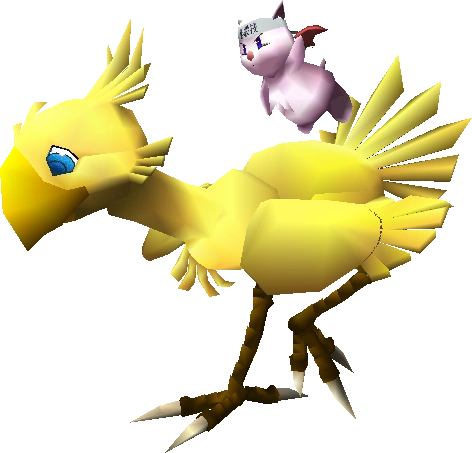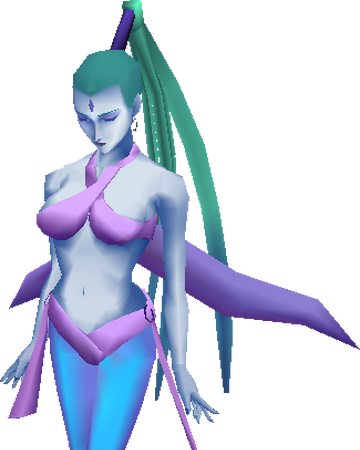SPOILERS AHEAD
![]()
When we first get to the Chocobo Farm, we can talk to the Chocobo behind the fence. Did you talk to the Chocobo?

For Final Fantasy VII’s first Summon Materia, blood-red like a ruby, you have to be willing to take the time to talk to everyone, including animals, and make the sound that the Chocobo makes. Careful how you pronounce your ‘Wark.’ Only by replying with the right one will it do its little dance and give you the power to summon it into battle. In this case, we simply imitate our interlocutor, not knowing what the sound means. But whenever an NPC conversation gives the player choices how to answer, whatever we think the best answer might be, the best of all would be to talk to them multiple times and make sure we see all of the branching dialogue, reaping any gifts or information possible.
In this way, playing a video game is a process of exploration akin to reading a choose-your-own-adventure book. Both tell a plethora of stories, only in the game both the immersiveness of the world and the pace of iterability are much increased. As a trade-off, the majority of the game’s branching dialogue so far has been along the lines of ‘Wark’ or ‘Warrrk.’ Whereas choose-your-own-adventure books are the original hypertexts, truly containing multitudes. Borges’ Library of Babel theoretically contains all possible books. One of the great literary experiments in branching storytelling, Cortazar’s Hopscotch, even includes a kind of Serpent of its own:
…sometimes at midnight the members of the Serpent Club used to get together to talk to a blind seer, a stimulating paradox. (6)
We can get lost in such books, wandering endlessly. This is just a refinement of the greatest danger, though, which lies in stasis, in getting stuck, either by never beginning or never finishing the story. Mythologically, we see such paralysis represented in the petrifying stare of the Medusa, snake-headed, slain by the aid of wings and reflections, or the gaze of the basilisk, traditionally stymied by the bird of wakefulness, the humble rooster. Or in this case, we avoid the terrifying Zolom by roaming free on a warking Chocobo.

With its help. we bypass the danger that might be too much for us at this point. Clearly much stronger than Cloud, who has a lot of developing to do before confronting him directly, the Zolom guards a cave full of much weaker monsters. One flame-throwing enemy skill we learn there foreshadows the much more powerful Beta we’ll be able to learn from the Zolom eventually. Mythril Cave, this area is called, suggesting the Mines of Moria passage in Tolkien’s Fellowship, with its Watcher in the Water out front, too.
No Balrog here on the other end of the cave. Instead, we meet the Turks. Their role has transformed; no longer kidnapping orphans and hunting AVALANCHE, they’ve essentially undertaken the same task we have from a different angle, working for Shinra. Like your party’s alter-ego, each of the Turks has a distinct personality under their classy uniform and cool theme song. Reno, wounded, sends his threats by his cronies: Rude with that bald head the arch-stoic; Tseng with his long hair and history with Aeris; and Elena, the new recruit who hasn’t quite settled in yet. In the Turks’ pursuit, we see the effects slowly rippling out from Sephiroth’s murder of President Shinra. We’ll meet them again many times as we traverse the world.
In this little scene with the Turks, we don’t actually fight them. Structurally, being the end of the dungeon, we’d expect a boss battle should take place. Instead, they depart each in their own slightly comical way. Shimmying up the roots to leave, as our characters do shortly after… we might wonder, by the way, how did Elena get up to that cliff? Does she have some version of Long-range Materia that works outside of battle? Or is it that she is placed there to correspond to that higher perspective we could not have attained without her, as she provides information about where they’re headed next. Irritating as it is to her companions that she doesn’t quite understand how to be a Turk, imperfectly laconic, Elena’s trying her best. And we’d have figured out where to go on our own eventually.

There’s Fort Condor and a ninja in the forest to think about, but first, how about we come back to the idea of a summoned monster? Many of the summons throughout the series have the names of gods and heroes, but rather than referencing anything specifically about those figures, they make up an index of meanings internal to Final Fantasy. The next red Materia we find (or the first, if we missed Choco/Mog) is Shiva. Clearly sharing little with the Hindu god other than the name, she refers instead to the established tradition of the series’ appropriation of Shiva as a powerful female ice monster. In general, we might say summons are representations of thoughts so enormous, be they religious or otherwise legendary, that they manifest as physical damage to the foe in the context of a battle. Why this damage should be ice-type rather than anything else when it’s Shiva causing it, who can say?
…Shiva is called the physician of the world,
by those who know the nature of the principles.Shiva is the great Atman,
because he is the Atman of all,
he is forever endowed with the great qualities,
there is no greater Atman than him.—Shiva Purana, Kailasa samhita, Chapter 9.17-22
(Abridged, Translator: JL Shastri)
In Junon, unlike Kalm, we find a city where everyone’s talking about Shinra. Maybe time’s allowing the news to spread, but it’s also a company town, a kind of mini-Midgar, with an upper and lower level to it. An odd cutscene greets us on coming into the old port town below. Priscilla, a girl who’s friends with a dolphin, is all set to introduce us when a sea serpent attacks.
![]()
So far, then, we’ve seen the Chocobos and the Midgar Zolom, the Condor at the Fort and a bunch of bird enemies in the area, and now this sea serpent. There’s a definite bird-snake-bird-snake thing going on. Like the White Wind Enemy Skill and Phoenix Summon materia we’ll eventually get from Fort Condor, the idea of healing comes in with that pattern here. In the absence of any other lifeguard, Cloud is called upon to perform CPR and bring this girl back to life. We raise her. If it’s a less flashy miracle than some others we might point towards, it’s one anyway that Cloud is capable of dealing with in that moment, despite his awkwardness about the mouth-to-mouth.
Cloud, doing Mr Dolphin a solid and saving the innocent girl out of nowhere, and with these symbols of transformation all around, primes us to see signs that we are on the appropriate path, with or without clues of where to go next.
![]() Wesley Schantz (the Bookwarm Mage) coordinates Signum Academy, writes about books and video games, and teaches in Spokane, WA. FFVII Myth & Materia comes out of his podcast series with Alexander Schmid and Vincent Reese.
Wesley Schantz (the Bookwarm Mage) coordinates Signum Academy, writes about books and video games, and teaches in Spokane, WA. FFVII Myth & Materia comes out of his podcast series with Alexander Schmid and Vincent Reese.
Did you enjoy this post? Consider becoming a Warrior of Light and join us in promoting honesty and quality to games writing through thoughtful, long-form critiques. We’re building a future for games writers to get paid and find a fairer and happier alternative to mainstream coverage and culture. See our Patreon page for more info!
